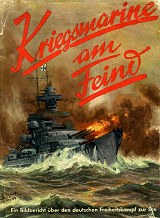THE LAST STAND OF THE BISMARCK
By José M. Rico
A desperate fight against impossible odds.
The sea ran high with the wind from the north-west at force 8 (34-40 knots). On board the Bismarck, the atmosphere on the bridge was tense, and they knew it was only a matter of time before the British engaged them with heavy ships. The German battleship was steering against the wind at seven knots. The flooding in the stern compartments had somehow reduced the bow trim although the ship had a slight list to port. At 0833, King George V and Rodney altered their course to 110º, and ten minutes later at 0843, they sighted the Bismarck at 23,000 metres (25,150 yards).
The Combatants.
| Ship: | |||||
| Displacement: | 51,700 mt | 41,000 mt | 44,400 mt | 13,400 mt | 13,400 mt |
| Armament: Main: Secondary: |
8 x 38 cm 12 x 15 cm |
9 x 40.6 cm 12 x 15.2 cm |
10 x 35.6 cm 16 x 13.3 cm |
8 x 20.3 cm - |
8 x 20.3 cm - |
| Armour: Belt: Turrets: Upper deck: Armour deck: |
320 mm 130-360 mm 50-80 mm 80-120 mm |
356 mm 184-406 mm - 159 mm |
348-374 mm 150-324 mm - 124-150 mm |
25-50 mm 25 mm - 35 mm |
25-50 mm 25 mm - 35 mm |
| Speed: | 30 knots1 | 21 knots | 28 knots | 32 knots | 32 knots |
The Rodney opened fire at 0847, followed by the King George V one minute later. The distance at this time was about 20,000 metres (21,870 yards). The Bismarck returned fire at 0849 with the forward turrets "Anton" and "Bruno" against the Rodney. Turrets "Cäsar" and "Dora" could not be trained at this time. On the contrary, the Rodney had all her nine guns positioned forward and the King George V added six more. So, the initial stage of this engagement consisted of an exchange between four German guns and fifteen British. The Bismarck was totally outgunned. Moreover, at 0854, the Norfolk joined the battle with her eight 20.3 cm guns, and at 0858 the secondary battery of Rodney joined the action. Nevertheless, just at this time the Bismarck managed to straddle Rodney.
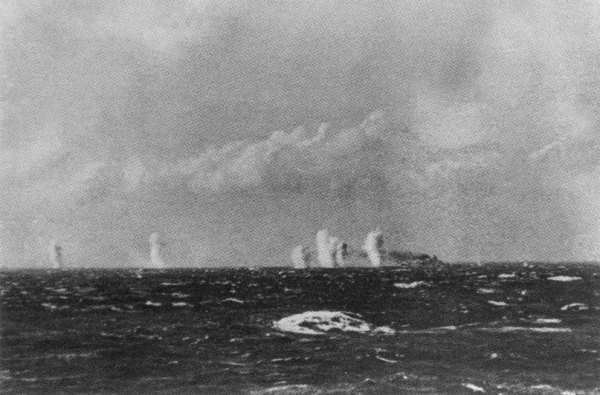
Bismarck's final battle has just begun and the first British shells fall near the German battleship on the morning of 27 May 1941.
Finally, at 0902, the Bismarck was hit by several shells that struck the forecastle, foremast and disabled the foretop rangefinder. At 0904, the Dorsetshire (Captain Benjamin C. S. Martin) which had just arrived, also opened fire. Two battleships and two heavy cruisers were firing against the Bismarck. At 0908, the forward range finder and turrets "Anton" and "Bruno" were put out of action. Bismarck's fire control was, therefore, shifted to the after command post. From there, the Fourth Artillery Officer, Kapitänleutnant Müllenheim-Rechberg directed four salvoes against the King George V. But at about 0913, just as he got the range, his station was also put out of action by a 14-inch shell that destroyed the cupola. The after turrets then proceeded to fire under local control at Rodney which, in the meantime, had launched six torpedoes at Bismarck, none of them hit. At 0921, turret "Dora" was put out of action after one of its own shells exploded inside the right barrel. At 0927, turret "Anton" or "Bruno" surprisingly fired one last salvo. Four minutes later, at 0931 turret "Cäsar" fired its last salvo. Only a few secondary guns were still in action, but these were soon to be silenced, too, by the enormous avalanche of British fire. At this time, Captain Lindemann, gave the order to scuttle and abandon ship.
Once the Bismarck lost her fighting capability, Rodney got closer, and from distances between 2,500 and 4,000 metres continued firing with her nine 16-inch guns against both sides of the German battleship. The hits continued. At about 0940, the rear wall of turret "Bruno" blew out and the turret caught on fire. At 0956, the Rodney launched two more torpedoes from 2,700 metres with one possible hit scored on the portside. From this point blank range it was virtually impossible to miss a shot, and shell by shell hit the Bismarck which amazingly was still afloat. Soon after 1000, the Norfolk launched four torpedoes from about 3,600 metres with one possible hit to the starboard side. The destruction aboard the Bismarck was complete, and men had begun jumping overboard. All guns were out of action, their barrels pointing in different directions at odd angles. The funnel and superstructure were holed in many places. The port forward hangar was demolished. In some places the decks looked like a slaughterhouse. Ironically, the main mast was still standing with the battle flag flaying with the wind. The Rodney ceased fire at 1016, and Tovey, short of fuel, was forced to leave the battlefield.
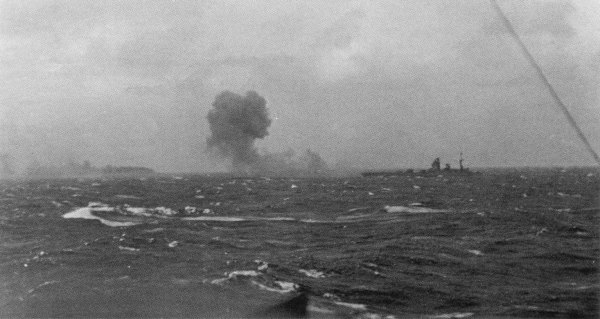
The battleship Rodney engaging the Bismarck on the morning of 27 May, as seen from the King George V.
The Sinking of the Bismarck.
At 0920, the Ark Royal had launched twelve Swordfish in order to attack Bismarck. The Swordfish striking force appeared on the scene at about 1015, but due to the heavy fire from the British warships stayed away. At first, the King George V mistook them by German aircraft, and even opened fire with her anti-aircraft battery, but fortunately no planes were hit. At 1020, the Dorsetshire closed the range and fired two 21-inch MK VII torpedoes2 from 3,000 metres at the starboard side of the Bismarck. Both of them hit, but no appreciable effect was observed. Then, the British heavy cruiser turned around, and at 1036 fired another torpedo from 2,200 metres against Bismarck's port side that also hit. The Swordfish circling over the area were privileged witnesses to this unfolding drama. By this time the German battleship had a heavy list to port, with the water reaching the upper deck. The port secondary battery turrets were almost submerged. Finally, the Bismarck capsized and sank at 1039 hours in the approximate position of 48º 09' North, 16º 07' West, within quadrant BE 5336.
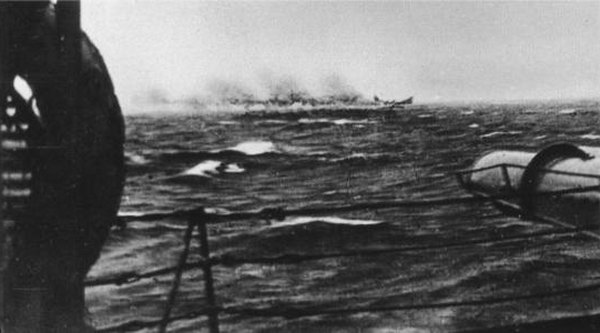
The Bismarck about to capsize sinking by the stern as seen from the cruiser Dorsetshire between 1036-1038 hours on 27 May.
Almost two hours had elapsed since the battle had begun, and the Bismarck had shown a formidable capacity of resistance. The British first struck Bismarck at 0902, and ceased fire around 1016. For 74 minutes, the Bismarck received a continuous hammering that no other warship could have taken. We need not forget that the Hood sank six minutes after the first German shells were fired only three days earlier. Moreover, neither the main belt nor the armour deck seemed to have been penetrated during the combat3, and in the end it was her own crew who scuttled the ship. During this last engagement 2,876 shells were fired at the Bismarck. They are itemised as follows:
-
380 of 40.6 cm from Rodney
339 of 35.6 cm from King George V
527 of 20.3 cm from Norfolk
254 of 20.3 cm from Dorsetshire
716 of 15.2 cm from Rodney
660 of 13.3 cm from King George V
It will never be known how many of them did actually hit (200, 300, maybe more?), but taking into account the short distances in the last phase of the action, it is assumed that many shells hit.
At 1100, only 20 minutes after the sinking, Winston Churchill informed the House of Commons gathered at Church House about the operations against Bismarck: "This morning shortly after day-break, the Bismarck virtually immobilized, without help, was attacked by British battleships that pursued her. I don't know the result of this action. It seems however, that Bismarck was not sunk by gunfire, and now will be sunk by torpedoes. It is believed that this is happening right now. Great as is our loss in the Hood, the Bismarck must be regarded as the most powerful enemy battleship, as she is the newest enemy battleship and the striking of her from the German Navy is a very definite simplification of the task of maintaining effective mastery of the Northern sea and maintenance of the Northern blockade." Mr. Churchill had just sat down when he was given a note, the Prime Minister rose again and said: "I have just received news that the Bismarck is sunk." The cheers were loud and long.
The official German announcement of the loss of the Bismarck was given later in the evening:
"Berlin, May 27, 1941. The Supreme Command of the Wehrmacht announces: The battleship Bismarck, which in her first battle against superior British forces sank the Hood and damaged the King George V, had her speed reduced by a hit forward. A torpedo from an aircraft attack that took place on the 24th of May, again affected her speed. On May 26, when 400 miles west of Brest, towards 21 hours, the ship was again hit by two aerial torpedoes from aircraft, destroying one steering gear and propellers, and the ship was unable to steer. During the night, the Chief of Fleet, Admiral Lütjens sent the following report to the High Command of the Kriegsmarine: 'Ship unable to manoeuvre. We will fight to the last shell. Long live the Führer. Chief of Fleet.' Contending with enemy naval forces which were gradually being reinforced, the battleship Bismarck went on fighting in her incapacitated state, until finally, on the morning of May 27, she fell victim of the superior strength of three battleships, an aircraft carrier, several cruisers and destroyers. The British formation itself has been attacked early today by German bombers. The thoughts of the entire German people are full of pride and sorrow towards the victorious fleet commander, Admiral Lütjens, during his naval battle in Iceland, towards the battleship Bismarck, her commander, Captain Lindemann, and his brave crew."
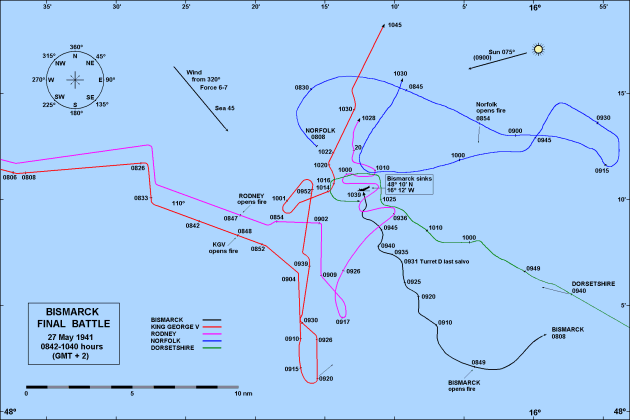
Survivors.
Around 800 sailors managed to abandon the Bismarck before she sank. The rest of the crew, many of them still alive sank with the battleship. An hour later, the Dorsetshire picked up 86 sailors and the Maori another 25. The temperature of the water was 13º C. The British did not recover more men because they claimed there were U-boats in the area. Towards 2000 hours, the U74 (Kapitänleutnant Eitel-Friedrich Kentrat) rescued three more sailors. They were Herbert Manthey, Otto Höntzsch, and Georg Herzog. The next day (28th), the German weather observation ship Sachsenwald (Leutnant zur See (S) Wilhelm Schütte) found two more, Otto Maus and Walter Lorenzen.4 Meanwhile, the Spanish heavy cruiser Canarias (Captain Benigno González-Aller) had left the port of El Ferrol at 1140 on 27 May in an attempt to rescue some survivors from the Bismarck. On 30 May, after a brief meeting with the Sachsenwald, the Canarias found two dead bodies floating in the sea which were pulled up aboard. These were Walter Gaszczak and Heinrich Neuschwander. At 1000 on the next day (31st), they were given a naval burial service and their bodies were committed to the deep. In the end, out of a crew of more than 2,200 officers, non-commissioned officers and men only 115 survived.5
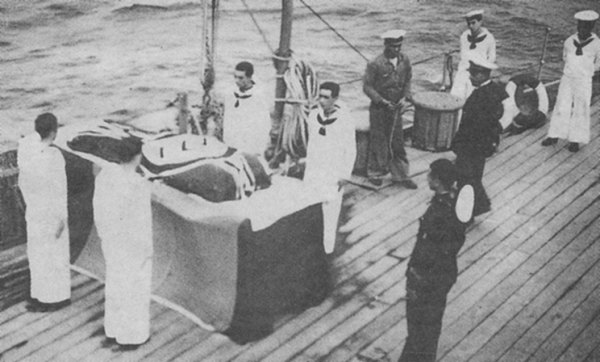
Ceremony aboard the Canarias for the Bismarck's dead.
Following the sinking of the Bismarck, German aircraft had been sent to look for Admiral Tovey’s force that had run low on fuel and was on its way back home. On 28 May, the destroyers Tartar and Mashona were attacked by German bombers. Mashona was hit on her port side by a bomb that exploded in a boiler room and later caused the ship to sink in position 52º 58' North, 11º 36' West. The Tartar rescued about 170 men, including Mashona's commander William H. Selby, but 46 men lost their lives. The rest of the British fleet reached port without incident.
The Prinz Eugen, in turn, had refuelled at sea from tanker Spichern on 26 May, but developed engine trouble the next day and was ordered by Group West to cut short her cruise and make for a French port. At 0605 on 1 June, the Prinz Eugen met the destroyers Friedrich Ihn and Bruno Heinemann that escorted her to Brest, arriving safely at 1930 hours.
Operation Rheinübung: Final Observations.
On 6 June 1941, Admiral Raeder reported the Bismarck operation to Hitler at the Berghof. Hitler asked why Lütjens didn't return to port after the engagement with the Hood, to which Raeder replied that a break through the northern straits at that time would have been a far more dangerous undertaking than a withdrawal to the Atlantic. Hitler went further and asked why the Bismarck didn't rely on her superior fighting strength to engage and destroy the Prince of Wales after the sinking of the Hood. Even if that resulted in the loss of the Bismarck, he argued, the British would have lost two capital ships. Raeder admitted that, seen in retrospect, a defeat of the Prince of Wales would, of course, have been a greater victory, however, Lütjens had to keep his operational orders in view as long as his ships were in a position to carry them out, and severe damage to the Bismarck in an all-out fight with the Prince of Wales would have interfered with any further operations against merchant shipping. His task, in fact, was to fight only when the enemy prevented him from attacking merchant shipping.
Although considered a fine commander, Admiral Lütjens has been unjustly criticised for some of the decisions made during Operation Rheinübung. Today with the benefit of hindsight, it is easy to conduct a deep examination of the operations and say what Lütjens should or shouldn't have done. But people should put themselves in place of the German Admiral and try to understand the difficulties that affected his decisions and the time and circumstances in which they were made. In any case, the truth is that both German and British committed a series of "reproachable mistakes" that made this story even more dramatic and interesting. If a single one of those mistakes had not been made, the course of the operations could have developed in a completely different way and the outcome of the battle could have been quite different.
From the operative point of view, Operation Rheinübung was a failure almost from the very beginning, since as early as 20 May, the German battle group had already been detected in the Kattegat. The British demonstrated that they had greatly improved their vigilance, and successfully signalled Bismarck's movements from her first arrival in Norwegian waters. The Germans, on the other hand, suffered from inadequate military intelligence and a lack of effective cooperation with the U-boat arm. Despite all this, the Bismarck almost escaped, and she would certainly have done so if it were not for that fatal torpedo hit that disabled the steering gear. Had the Bismarck reached France, the ship and her crew, whose conduct was in every way exemplary, would have undoubtedly been welcomed as the greatest heroes. The sinking of the Hood followed by a successful escape would have given the Germans a great victory. However, their primary objective (sink enemy merchant shipping) wouldn't have been accomplished. Therefore, despite of damaging the prestige of the Royal Navy, Bismarck's sortie would still be somewhat of a failure. Moreover, due to the damage received at the Denmark Strait and the following torpedo hits, the Bismarck would have had to enter dry dock for repairs. This would frustrate her prompt return to the Atlantic as the battleship could not be utilized again for at least the next couple of months.
For the German Navy the sinking of the battleship Bismarck was probably the heaviest single blow of the war. Nevertheless, the Kriegsmarine still had considerable striking power and was far from being defeated as the year 1942 proved; however, the loss of the Bismarck marked a turning point in the war on Allied merchant shipping. Not only because of the loss of the battleship itself, but because the consequences that it brought. Shortly after Operation Rheinübung, the Germans abandoned the use of heavy surface warships for raiding purposes in the Atlantic. From then on, only a few auxiliary cruisers remained engaged against enemy merchant shipping, but even their use proved difficult by the end of 1941, and therefore the Germans concentrated their efforts in the U-boat war. U-boats would still bring important successes, but they, too, were eventually defeated in May 1943 with the loss of 41 units, in what it can be considered as the other turning point in the Battle of the Atlantic.
The aircraft carrier had revealed itself as a decisive weapon and soon was to replace the battleship as the ultimate warship. This was confirmed six months later during the Japanese attack on Pearl Harbour, and during the Battle of the Coral Sea, the first true aero-naval battle in history between two carrier forces. Today, now in the 21st century, the battleship era is long gone, but the story of the Bismarck and her brave crew still fascinates thousands of people worldwide and her legend is still very much alive.
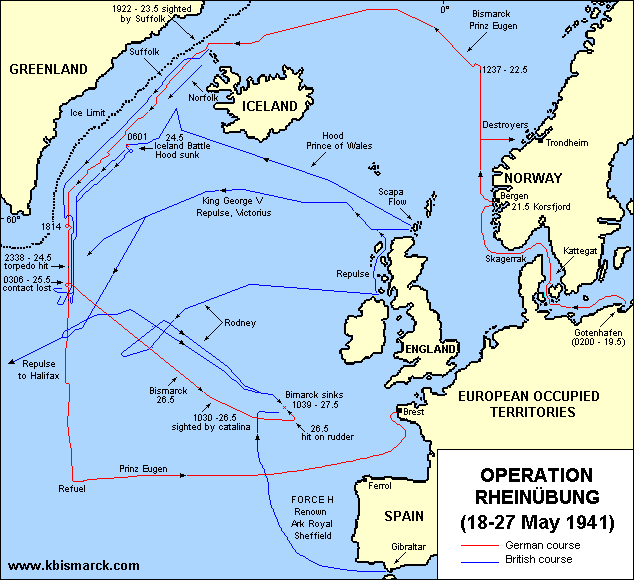
Footnotes:
1. Bismarck's speed is irrelevant in this case as she was only doing seven knots during the final battle.
2. The MK VII torpedo weighted 1,409 kg (3,106 lbs) and had a warhead of 336 kg (740 lbs) TNT.
3. The most recent survey of Bismarck’s wreck showed only two complete penetrations in the lower 320 mm main belt, both on the starboard side. These penetrations must be credited to Rodney’s 40.6 cm guns since the King George V always kept herself on Bismarck’s portside throughout the battle.
4. The Sachsenwald (Bau-Nr. 0631) was a 639-ton fishing vessel (Fischdampfer) built in 1939. During the war she was used as a meteorological weather observation ship (Wetterbeobachtungsschiff 7) and later became the Outpost Boat 414 (Vorpostenboot 414) serving with the 4th Outpost Flotilla (4. Vorpostenflottille) in the Bay of Biscay. Vorpostenboot 414 was sunk on 6 August 1944 north of Ile d'Yeu off St. Nazaire, by a British naval squadron composed of the light cruiser Bellona and the destroyers Tartar, Ashanti, Haida, and Iroquois.
5. A total of 116 men were picked up alive by the heavy cruiser Dorsetshire (86), the destroyer Maori (25), the U74 (3), and the weather ship Sachsenwald (2) after the Bismarck sank. The Maschinengefreiter Gerhard Lüttich was picked up alive but died on board the Dorsetshire on 28 May 1941 because of his wounds.

Copyright © 1998-2024 KBismarck.com


